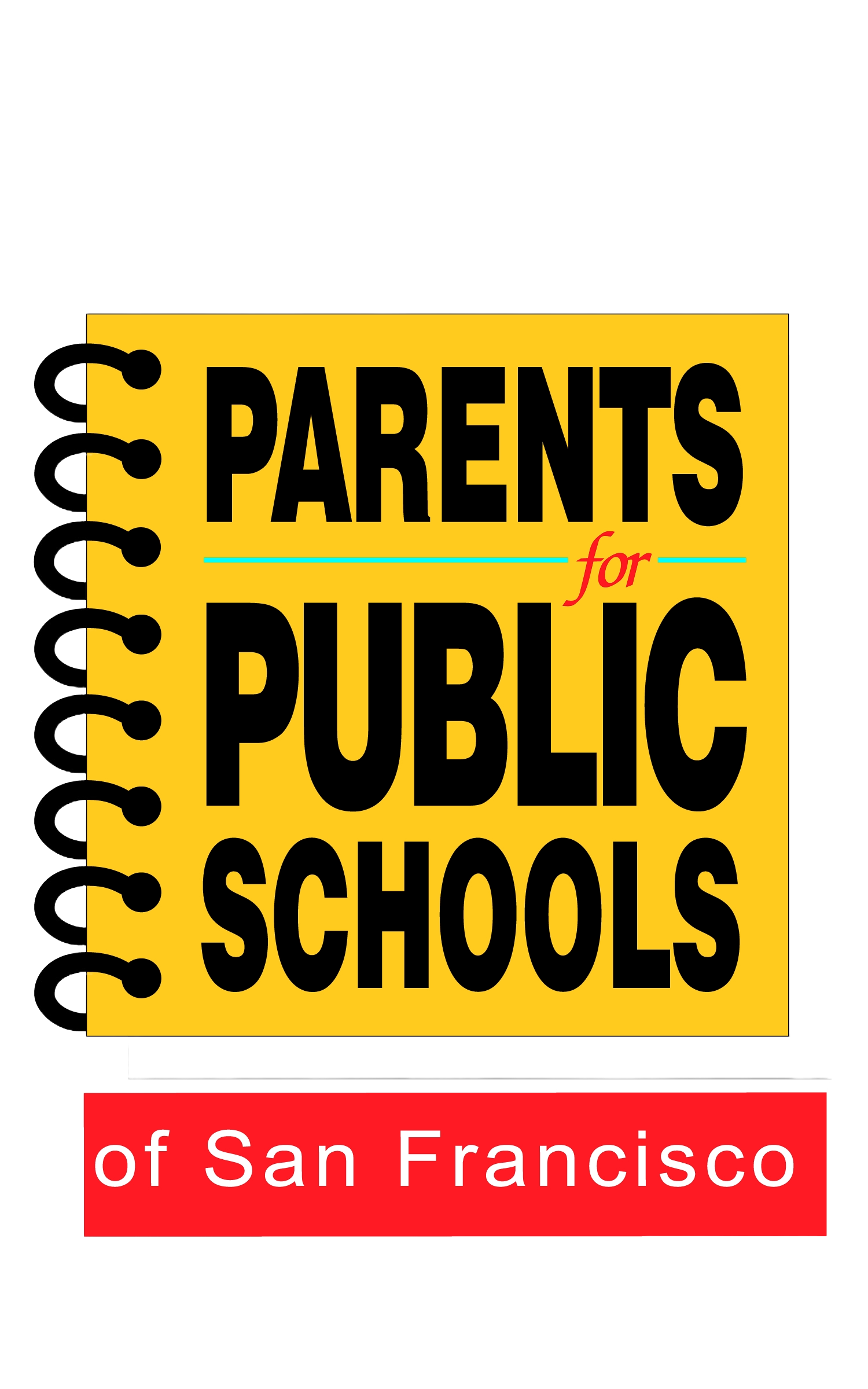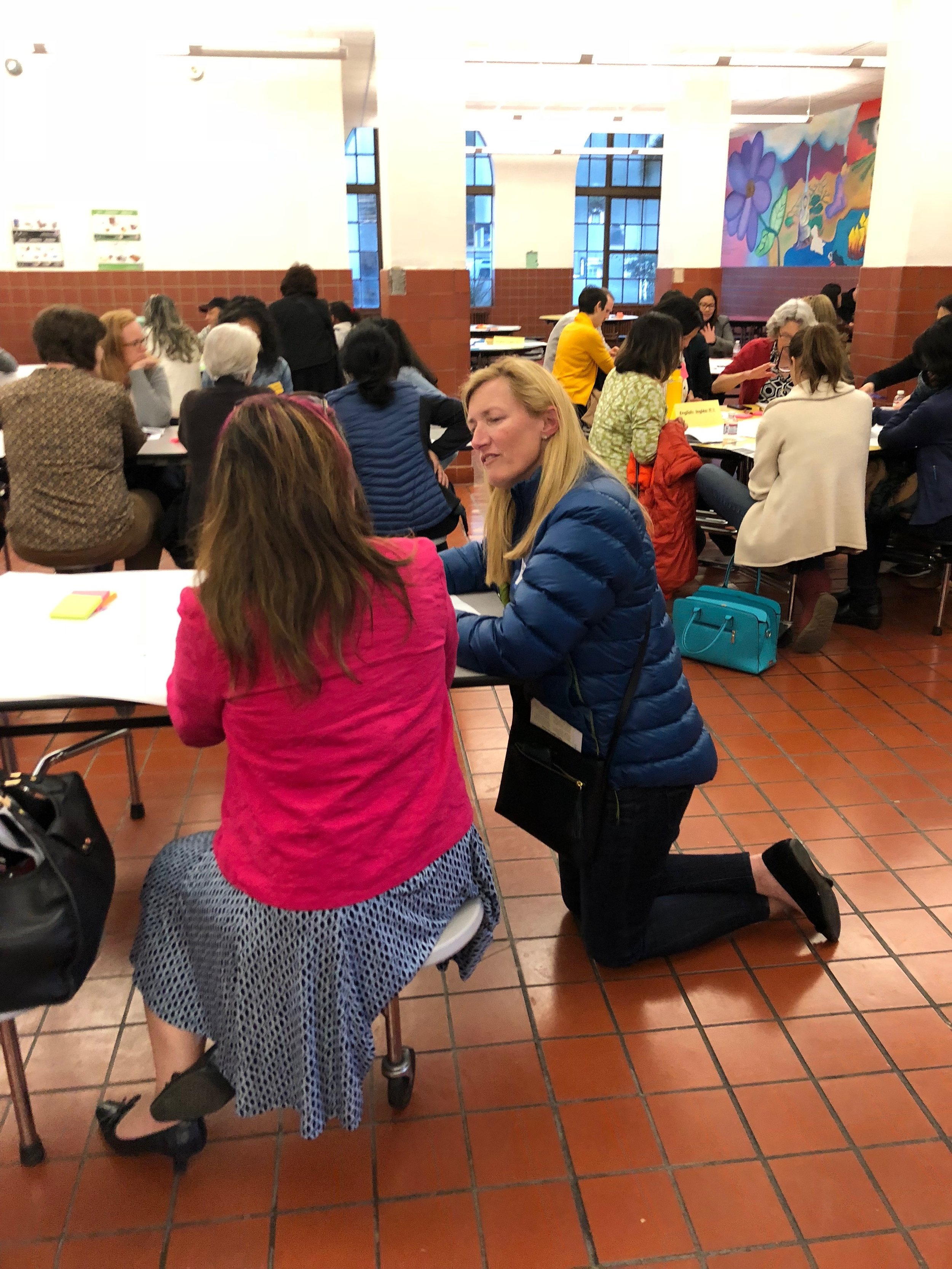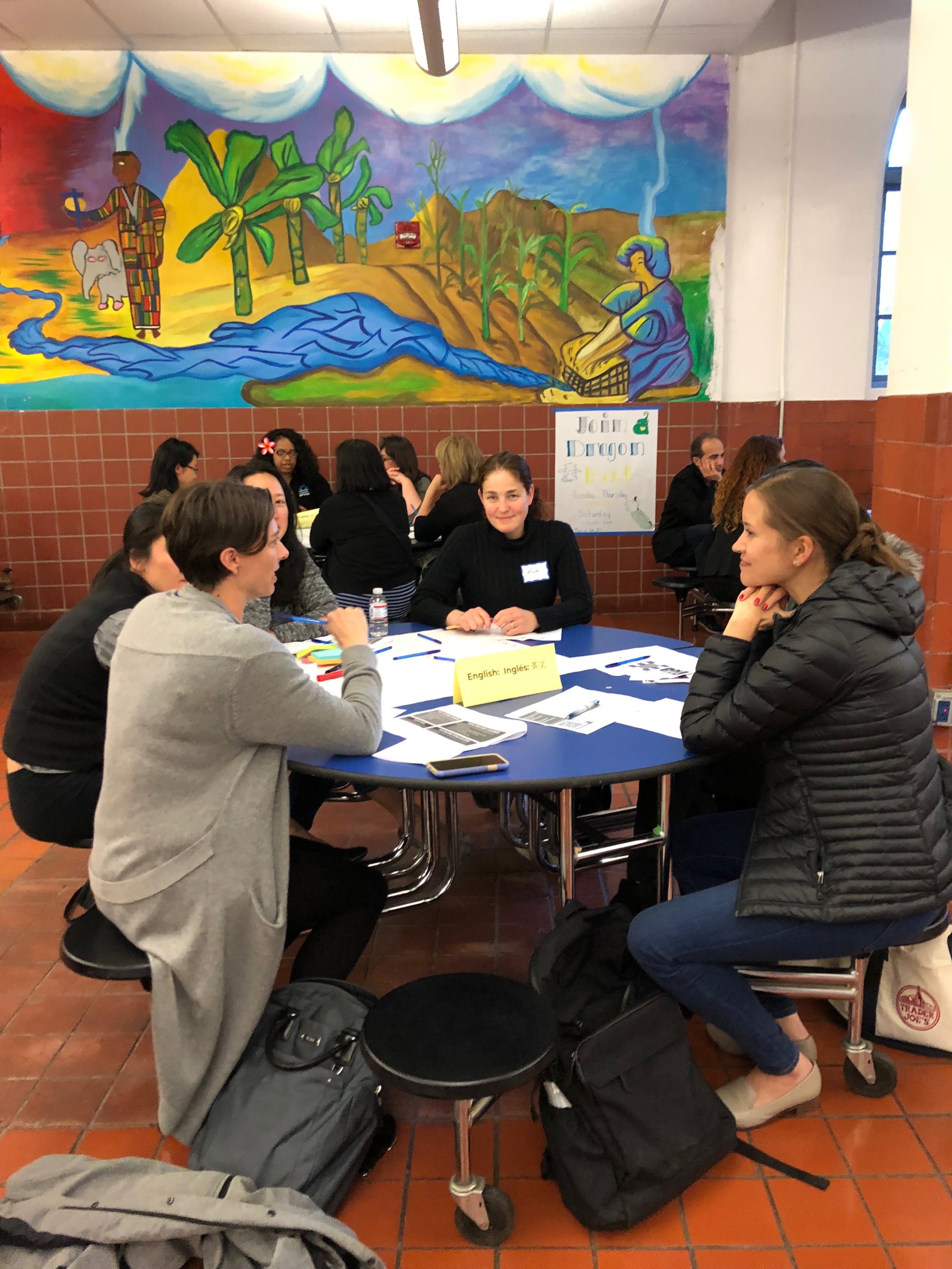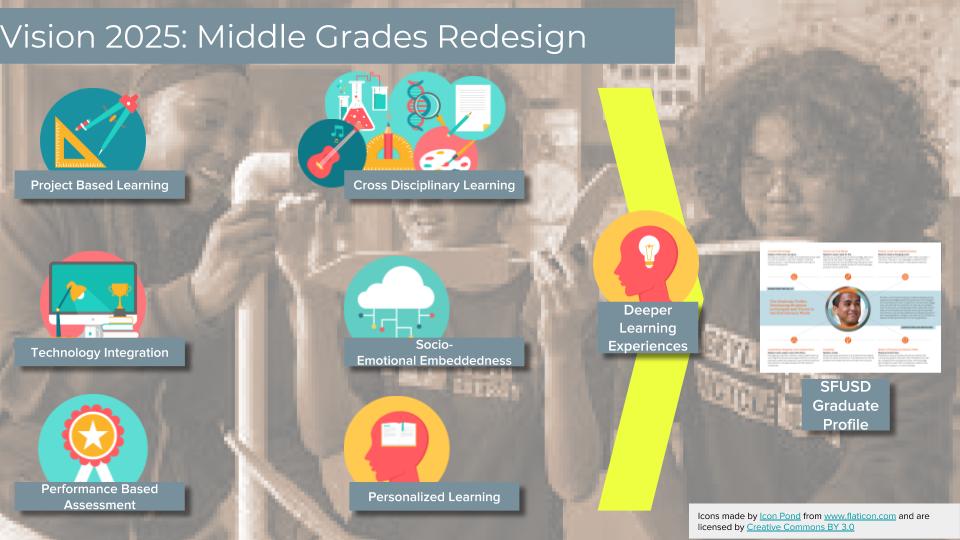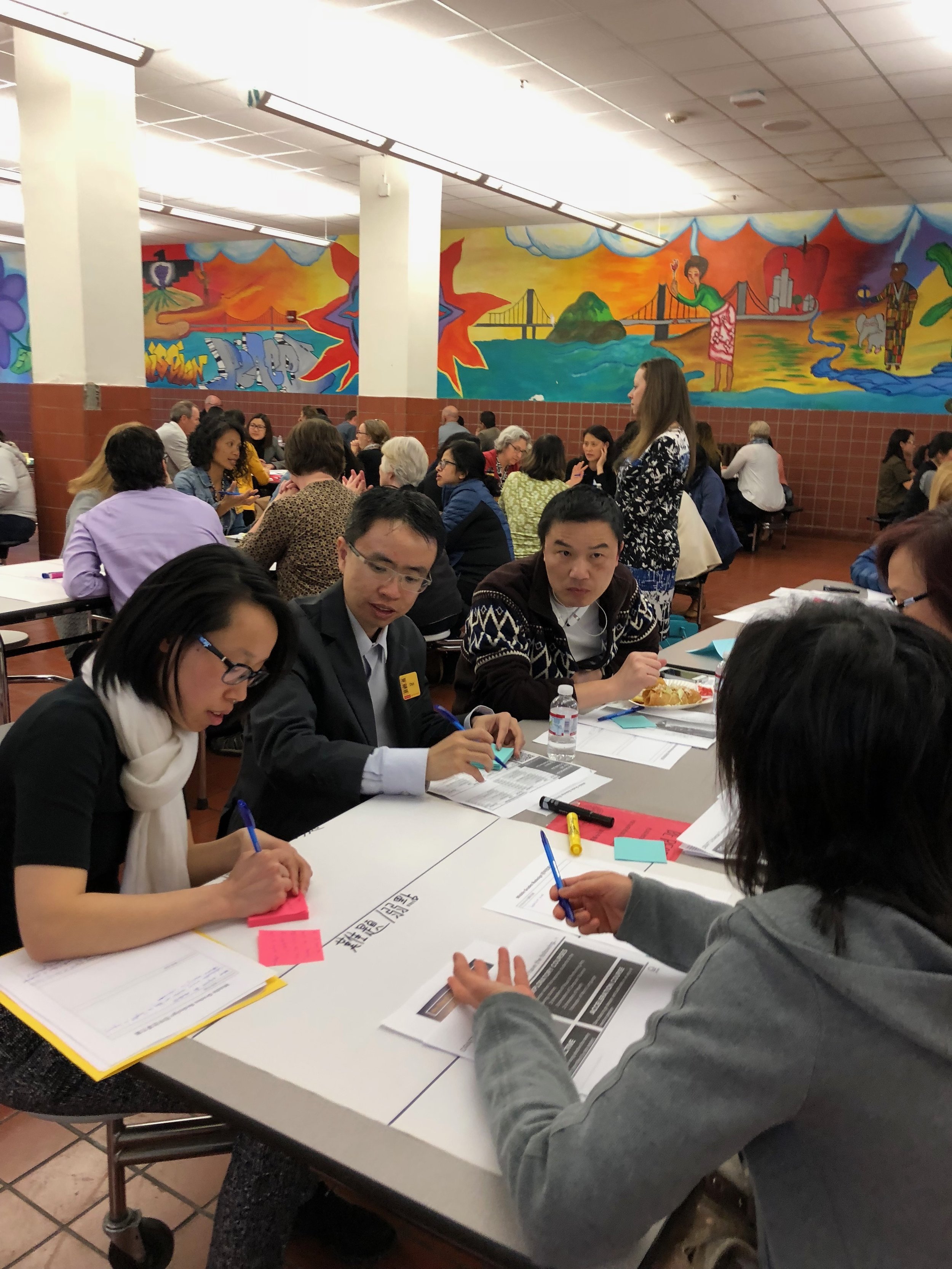SFUSD Middle Grades Redesign: What We’ve Heard From Families So Far
The topic sparked interest!
Over 125 participants joined the evening discussion on Middle Grades Redesign hosted by SFUSD and PPS-SF at Mission High School on April 26, 2018. For a recap of the event and links to the information presented, click here.
Almost all participants stayed for an interactive feedback session to discuss strengths and challenges of the proposed changes to SFUSD's middle school experience and identify questions that came up for them. In all, we collected over 700 comments which we transcribed, analyzed and shared with the team at SFUSD overseeing the Middle Grades Redesign.
Middle Grades Redesign Community Feedback: Strengths Identified (by Theme)
Middle Grades Redesign Community Feedback: Challenges Identified (by Theme)
Middle Grades Redesign Community Feedback: Questions Identified (by Theme)
Electives: more options and greater equity of access are big pluses for families.
When it came to strengths of the proposed plan, greater choice in electives was mentioned most frequently by families at the event. Many comments specifically mentioned an appreciation of increased access to world languages and visual and performing arts as well as computer science.
Families recognized that currently some students, like those learning English or needing special education services, do not have equal opportunity to take electives in middle school. They appreciated the more equitable access that would be provided in the new system.
However, some did have questions about whether choices for electives would still vary from school to school and how much flexibility students would have to switch from one elective to another over the course of their time at middle school.
Proposed shifts in schedule and structure of the day met with a mix of excitement and concern.
The proposed redesign includes elements that would change the current daily schedule of students in middle school. Schools would shift from a six-period day to an eight-period block schedule. In a block schedule, most days students don't attend all of their classes, but the classes they do attend meet for a longer block of time - about 1.5 hours. It was also proposed that one day each week students would have a 2-hour "early release" to allow teachers and other staff across the district to collaborate and participate in professional development.
Participants saw strengths all of these changes, with many comments noting the importance of common planning time for teachers which early release enables and also the benefit of longer learning blocks to enable deeper and cross-disciplinary learning.
"Longer class periods are excellent and really needed for project-based learning"
"It is wonderful to see that there are other focuses besides academics."
-Participants
On the flip side, many families were concerned about challenges that may be raised by block schedules. Specifically, participants mentioned concerns about the lack of daily instruction in subjects like math and world languages; the confusion students might face navigating different daily schedules; the potential difficulty of making up classes after an absence; and the possibility that longer classes may make it harder for students to stay engaged - especially if teachers are not used to engaging students for longer periods. Some specifically noted the age of middle schoolers in raising concerns about whether a block schedule would be manageable. Others wanted to make sure that plans were in place to support students caught in the transition to the middle grades redesign, and may experience a major shift mid-stream in their middle school journey.
Families also had concerns about how early release might impact their lives. Almost 13% of comments relating to challenges mentioned early-release specifically. Many participants cited questions about capacity and challenges related to the cost of aftercare options. Others noted that logistically it would be very difficult to navigate pickups for multiple children attending different schools across the city if all schools had the same release time. Some were also worried that students would lose instructional time and have too much unstructured time on early release days.
"Will there be enough room and staff to accommodate extra kids in aftercare on Wednesdays?"
"Uniform days off will make pickups harder for parents with multiple children."
"Early dismissal every Wednesday is an incredible hardship on working parents. Debilitating financially and exhausting from a logistics point of view."
-Participants
Participants voiced much love for project-based learning and other instructional shifts; but shared concerns about time and resources to support a meaningful change in teaching practice.
Driving many of the proposed redesign elements is SFUSD's Vision 2025, a plan, developed with community input in 2014, that identifies the "knowledge and skills" students will need to "compete and thrive in the 21st century world." To fully implement this plan, district leaders have identified needed instructional shifts which are built into the vision of the Middle Grades Redesign. These include: project-based learning, cross-disciplinary learning, technology integration, socio-emotional embeddedness, personalized learning, performance-based assessments, and deeper learning experiences.
A full ten percent of comments about the strengths of the Middle Grades Redesign specifically mentioned the embrace of "project-based learning" as an area of strength. Deeper learning experiences, more personalized learning, cross-disciplinary approaches and integration of social and emotional learning were also frequently mentioned as strengths of the plan. They were curious about how the city and community could be integrated into student's learning experiences. Parents were excited about the prospect of students having more "hands-on" opportunities, building "real-world" skills and engaging in collaboration with each other and across disciplines.
"How is social-emotional learning built in throughout this curriculum?"
-Participant
This enthusiasm was tempered by the recognition that implementing these instructional shifts is not easy and will take time, resources and educator buy-in. More than 30% of feedback about challenges the plan may face and 39% of questions related to concerns about the feasibility of implementing change on this scale. Parents worried about the resources needed to make this change successful and questioned where needed funds and additional staff support would come from. Comments also focussed on the need to have a "plan," that included "goals," and "accountability," as well as strong on-going support for principals, teachers and other staff, including training, curriculum, and equitable access to technology.
"How will SFUSD pay for this?"
"What resources will teachers have, including coursework?"
"Project-based curriculum is very difficult. How will teachers be supported and held accountable?"
-Participants
The concept of "acceleration for all" received positive feedback, but some participants were unclear on the details and concerned about staffing.
A unique element of the Middle Grades Redesign proposal is the daily acceleration period, which would allow students to participate in need or interest based coursework. As proposed, all students would take an acceleration class to "go deeper or build skills in an area of need or passion." Versions of this approach have been tested in local middle schools. Families who provided feedback on the idea of acceleration appreciated the personalization it provided to deliver instruction supporting individual students' needs and interests. Questions and concerns again focus around implementation - participants wanted more details about how acceleration would work, how students would select or be assigned to classes, and how teachers would be hired, trained, and supported to provide this specialized instruction to students.
Some parents were concerned that these classes would be perceived as "tracking" and others wondered how students with multiple needs would navigate the system. Still others wanted more details about exactly what type of classes would be offered, if offerings would be the same at all schools, and what curriculum and other supports teachers would have to make this period effective. Several passionately worded comments expressed the desire for students who love math to be able to use this period to take 8th grade algebra.
Several comments noted that the acceleration period as proposed was shorter than other classes (30-40 minutes per day) and wondered if that allowed enough time for students to "catch up" or "go deep." Parents who had experienced acceleration at other schools noted that class sizes were typically small and wondered if there were enough teachers to support a low student/teacher ratio in the proposed system.
"Interest based learning will or may generate more engagement."
"What if a student has multiple needs? How is just a few acceleration periods help if the need is greater?"
"Identify kids strengths and weakness: by test or by teacher recommendation?"
-Participants
Questions were raised about the impact of proposed changes on immersion programs and K-8 Schools. Families also wanted more information about the proposed new advisory system and to know which schools will be first to pilot changes.
While receiving smaller overall numbers of comments, a few additional topics raised are worth noting. Parents of students in immersion programs and K-8 schools wondered how these shifts would play out in those programs. In particular, families at K-8 schools wondered how a smaller school could support the breadth of choices in electives and acceleration options available at larger comprehensive middle schools.
There was also a cluster of questions about the advisory period shown on the proposed schedule as meeting one afternoon per week. Some wondered what its purpose was, and what could be accomplished in that time slot.
Finally, in the presentation it was mentioned that three schools would be "piloting" elements of the redesign this fall. Many people were very curious to know which schools these would be! (Answer: the pilot schools are still TBD.)
Thanks to all who participated in the Middle Grades Redesign event and provided rich feedback. Stay tuned for more on this topic in the fall!
